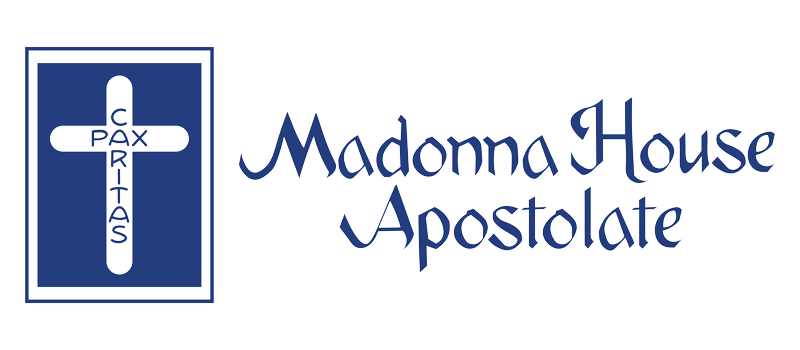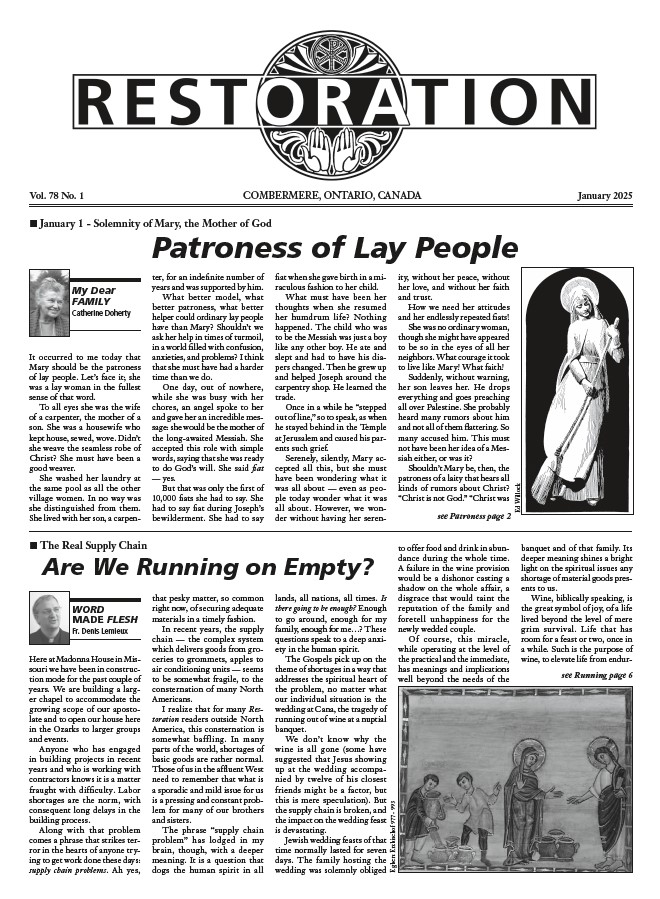This content has been archived. It may no longer be relevant
As has been occasionally remarked on in Restoration, one of the odd vagaries of writing a monthly newspaper with its long time between preparation and mail-out is that one has to write articles about liturgical feasts and seasons at strange times of year. Thus you write about Lent during the Christmas season and Christmas in October.
Such is the case this month. I am writing this article about the glorious feast of Easter—the explosion of light and love into the world, the grand and definitive Springtime of God, victorious in his “arising from winter’s death and cold,” as we sing in one of our hymns.
And I am writing it in early February! Looking out my poustinia window, I see gray overcast skies over a field of deep snow.
A raw wind from the north promises us more snow this evening. The weather forecast, too, promises more of same … and same … and same. It is winter, and will remain so for quite some time.
Well, Christ is risen, alleluia! Pondering the contrast between the leaden winter day outside and the reality of Easter, it occurs to me that this is actually the best time of all to be writing about the Resurrection.
All growing things—the perennials I so carefully tended in my garden all last summer, the grass in the cow pasture adjoining my cabin, the weeds and wildflowers that grow rampant across the landscape—all seem to be, to any outward eye, dead frozen, frosted to the roots: winter kill.
The expanse of deep snow, the howling of the north wind, the knife-bitter chill—all seem to proclaim the victory of death, that death has conquered, and that all life, at best, holds a temporary claim on the land.
“Today the lilies and the phlox; tomorrow it’s your turn, Lemieux.” Or so the wind seems to say as it howls around my cabin.
Well, we know the wind is a liar. We’ve been through this many times before, after all. This is my 53rd winter on the planet, nearly all of them spent in Canada.
The world comes back to life, in these parts, somewhere in late April to early May. We know this. Every year the little miracle of nature’s resurrection bears witness to the Great Resurrection all flesh longs for.
By the time you are reading this article, the “little Easter” of the earth will have most likely come to your parts. But … what about that other winter that haunts us? You know the winter I mean? When will the warmth and light of spring thaw that winter?
What winter? Oh, you know—the winter of humanity. The growing cold of the heart of man. The winter-kill of hope and faith in the lives of so many. Simply, the failure of love. In this year 2019, those arctic winds are howling around many a house.
They roar around families, communities, parishes, leaving cold indifference in their wake, where warm love and friendship should prevail.
They howl down the corridors of power and influence in nation upon nation, battering and tearing at the fabric of social cohesion and common cause, leaving the world more and more polarized, indeed.
Oh, there is trouble and strife aplenty in all lands and nations these days, and drifts of moral principle, and treacherous black ice threatening to derail the car of progress to disastrous effect.
That’s the winter I’m talking about, and it may not be over, quite, by late April-early May!
So … Christ is risen, alleluia? This is the question that confronts us every Easter, doesn’t it? In a world that is so marked by death, where death does indeed seem to get the last word in so many ways, is Christ risen? And does it make a difference if he is?
Christ is risen, from the dead, as we sing at Madonna House at Easter, over and over again.
That second phrase is important, you know. Christ rose, but he died first. He rose “from the dead.” We cannot really understand the meaning and import, and the unfathomable joy of Easter, if we do not understand, experience in some fashion, the dreadful tragedy and searing pain of death as well.
At the same time, we cannot confront death in whatever form we encounter it—be it in the fearsome cold of a long hard winter, the tragic prospect of a world and a society choosing sin and death in so many ways when the path of life lies open and clearly marked before us, or the final reality of our own deaths and the deaths of those we love—without the knowledge of what Christ has done to death in his rising from it, what the resurrection means for the world and for every living thing in it.
It means that, no matter what the appearances, no matter how bleak the outlook, no matter how difficult the times in which we live, death does not, never has, and never will have the last word in the life of any of the living, no matter how “dead” we may be. Not if we don’t want it to, and really, who would be so foolish as to want that?
Christ is risen from the dead, and so all “the dead” have a way out, a way he fashioned himself with his own risen body, a way that is available to all.
And that makes the most bleak and hopeless winter of our souls and bodies only the outer veil for a hidden unconquerable spring, only a time of waiting for the new life to break out of whatever tomb it has been encased in.
Christ is risen. Truly, He is risen. And we are risen in and with him. We need only choose to believe, and thus enter into that risen life. Alleluia, alleluia, alleluia!





